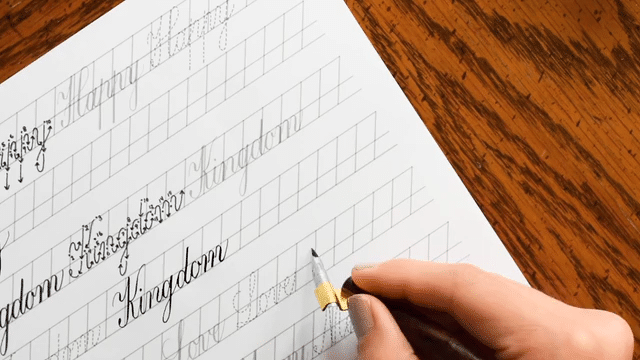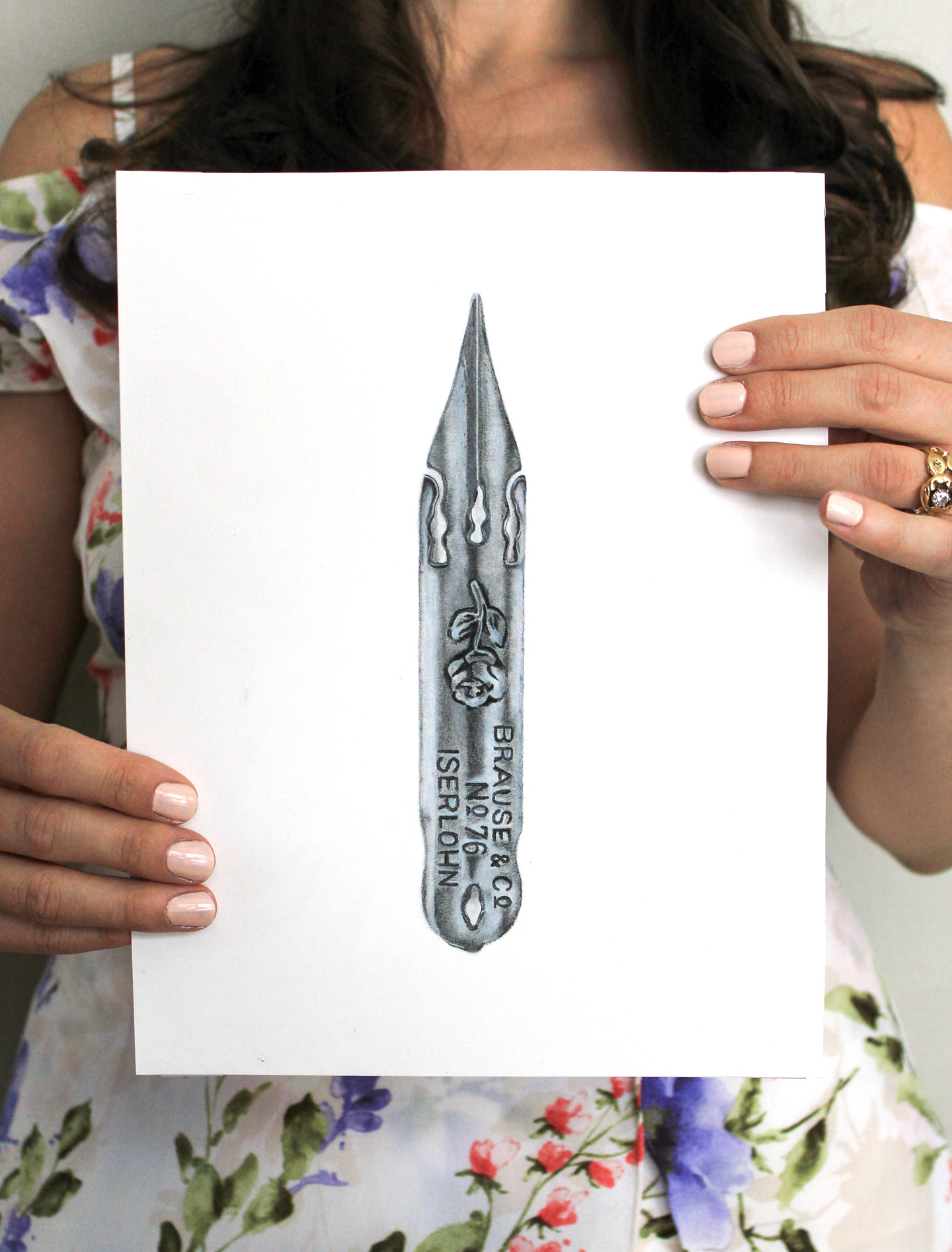
Some of my favorite clients are Etsy entrepreneurs — people who want to vamp up their shops with a one-of-a-kind banner, business card design, stickers, etc. When I work with these clients, I ask them to provide me with a Pinterest board of graphics that inspire them; graphics that have “vibes” they would like their own shop to echo. I also ask for five adjectives that the client would like the final product to be described as — for example: whimsical, pretty, vintage, artistic, eclectic.
Yesterday, I became my own client as I finally reached my breaking point with my out-of-date business cards. I had them printed over a year ago, and they don’t reflect the aesthetic of my business now.

I used moo.com to print the cards above. While they are excellent quality {physically}, the design on the front is chaotic, the back features an outdated logo, and the overall “feel” doesn’t reflect my business anymore. In short: they’ve got to go.
In order to create a new business card design, I asked myself the same questions I ask my clients … and I found that I am my own nightmare client. It’s so easy to work off of other people’s ideas … but my own? That’s where I hit a brick wall. Because I am used to having some sense of direction or some guidelines, coming up with designs for me is always a challenge. For months I have been trying to come up with the perfect business card, and for months I have been striking out.
But yesterday, by some stroke of luck, the inspiration fairy paid a visit to me. Now I’ve finally got a business card design I am happy with.

Business card designs seem like they would be hard to create … but even if you are not a designer, you can DIY it pretty painlessly. What if I told you I used online software to create my business card template, and you could easily do the same? Keep reading to find out how you can A) create DIY business cards to print off at your local printing center or at home, and/or B) create business cards using moo.com.
Business Card Design for DIY Printing
First, I am going to show you how I DIY’d my own business card design and printing. I knew that I wanted to print my design off on 110 lb. card stock purchased from Michael’s. {Just something to keep in mind: many home printers cannot handle this weight of card stock ; it is best to take the card stock to a professional printer.} I also knew that I wanted the card to print front and back with perfect alignment. I needed a template.
Upon considering the facts, I paid a visit to Avery Design & Print Online. There, I chose the “Business Cards” option.

And I chose the “Two Sided Business Cards – White” {a horizontal orientation}.

I was then led to a design center, which was very easy to use. It was almost a rudimentary, more user-friendly version of Photoshop. On top, you can see whether you are designing the front or the back of the business card. On the left, you have a panel where you can add text boxes, images, shapes, etc. The first thing I did was add an image: a stroke of watercolor that I made by hand and modified slightly with imaging software {Photoshop}.

As long as your images don’t have backgrounds (i.e. they are .png files), you can layer them. As you can see below, I layered a calligraphy “hello” on top of my watercolor. If you love calligraphy and you do happen to have Adobe Illustrator, Courtney from A Bevy Of has a great tutorial on how to convert the fruits of your handwriting labor to a vector graphic {which I did with my “hello”}.

Finally, I added some simple text to the bottom using the “Add Text Box” tool: a web address.

To create the other side, I simply clicked “Back of Card” and repeated adding graphics and text until I got a back that I was happy with. Once I was finished with both sides, I clicked “Preview & Print” {upper right corner, green button}. This led me to a screen where I could preview my cards in 3D.

From there, I chose “Print Front and Back of Sheets” and clicked “Print”. This led me to a printing screen — but I didn’t want to print at home, so I clicked “Cancel”.

This left me with the PDF sheets, which I simply right clicked and saved.

Next, I went to Fed-Ex/Kinkos Office and Print Center. I do realize that many of you may not have access to a place like this; if you do not live near a local printer, you can print these off at home, or read on to find out how to make a business card design on moo.com {because they’ll ship the cards to you}. Now, for those of you who do live near a Fed-Ex/Kinkos, if you arrive with your own card stock, the printing cost is around $0.50 per page — or $1.00 per sheet of 10. I used one of the self-service printers, and then I used the industrial paper cutter to cut my business cards apart. Here’s what the template looked like after a couple of cuts:

{You may notice this is a different type of paper; I initially planned on printing out my cards on watercolor paper, but found the ink didn’t quite agree with the texture and ended up being dull. Fluorescent white card stock is your best bet.}
And voilá! The finished product:

Business Card Design + Printing Using Moo.com
I am in love with my cards, but when I noticed that moo.com is having a 25% off print sale that ends January 27th, I jumped at the chance to have my business card design printed off on their signature super thick luxe paper with a black core. If you are proficient in Photoshop or Illustrator, you can upload a complete design to moo — they provide templates so you can make sure all the images won’t get cut off. However, if you are not a designer, there’s no need to sweat. In fact, catering to non-designers is where moo excels! I love moo because it really guides you through the design you are creating — and while you can’t layer images, it’s easy to come up with a great design with little knowledge of printing technicals.
I have been working with Michelle of Owl & Peony lately, so I’d like to demonstrate how to create a business card on moo.com using the graphics I designed for her.
First, you’ll go to moo.com. On the home screen, hover over “Business Cards” on the options bar at the top. On the menu that appears, hover over the option you want. I recommend Business Cards or Luxe Business cards; the cards shown earlier in this post are Mini Cards and are also a good, cost-effective option. Click “Design Your Own” next to the card of your choice.

You’ll be led to a screen that looks like this. The first thing I do is choose the layout I want. Note that the orange bar with the milk drop/tear drop graphic denotes where your graphic will go. For Owl & Peony’s model cards, I want a vertical card with a graphic up top and text filling the rest of the card. So, I will choose the second option from the right:

Once you select your layout, the screen will prompt you “Click to add an image or logo or drag here.” Click that box, and you will be led to a screen where you can upload graphics.

As you can see, I have clicked the “Upload Images” button and uploaded my calligraphic “Owl & Peony”. Once you have uploaded the image you like, click “Add to Card” {bottom right; gray and orange button}.

Once your image is placed, you will need to re-size it using the “Zoom” feature. You can also rotate it, or remove it if things just aren’t going as well as you thought they would with your image. Moo is really good about letting you know what’s going on with the dotted lines and how your image is going to print out.

When your image is satisfactorily positioned, you’ll move on to text. This bit is self-explanatory; you will choose the fonts that “speak” to you and modify the font size and orientation until you are happy with it. I have opted for small, simple text in order to complement the open and minimalistic design.

Once you are finished, click “Next Step” {bottom right, orange button}, and you will be led to a screen that allows you to design the front of your card. I of course needed to change the orientation {see the magenta arrow} because my business card design is vertical.

Then I simply uploaded the watercolor owl with a peony crown that I created for Owl & Peony’s marketing materials.

And that’s it. Once you’ve completed these steps, you’ve designed your business cards! Now, you’ll click “Next Step”, where moo will prompt you to double-check your card design to ensure it’s exactly what you want.

Then you’ll decide which type of paper you want {click “More Info” to find out about the different kinds of papers}, check out, and have your cards the next week.

As I mentioned, moo.com is having a 25% off sale, which ends January 27th. If you are reading this post after that date, my apologies! But if you are reading this post within the proper time frame, I’d encourage that you purchase from moo this week. Follow this link to get an additional 10% off your business card order {the 10% off is applicable whether you order now or in a year}. I purchased my own business cards this morning on a referral, and the 25% plus an additional 10% off was a wonderful excuse to splurge on luxe.
I hope that this post has given you some clarity on making your own business cards, calling cards, or even play date cards! If you have any questions or input, please let me know in the comments. Otherwise, stay tuned for my next blog post over 2014 goal lists, which will appear on Saturday {notice I am holding myself to blogging more}!
As always, thanks a million for reading. I love having you here!



























